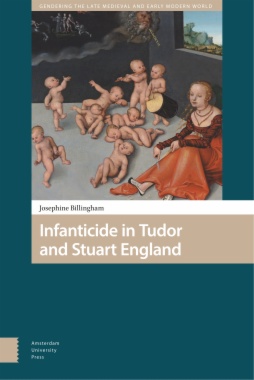Infanticide in Tudor and Stuart England explores one of society’s darkest crimes using archival sources and discussing its representation in the drama, pamphlets and broadside ballads of the early modern period. It takes the reader on a journey through the streets and taverns where street literature was hawked, to the playhouses where the crime was dramatized, and the courts where it was tried and punished. Using a regional microstudy of coroners’ inquests and churchwardens’ presentments, coupled with theories of liminality, marginality and rites of passage, it reveals complex and contradictory attitudes to infants, women and the crime. As well as considering unwed women, the most common perpetrators of infanticide, the study shows that married women, men and the local community were also culpable, and the many reasons for this. Infanticide in Tudor and Stuart England is set in its European and historical contexts, revealing surprising continuities across time.
- Cover
- Contents
- Acknowledgments
- Author’s notes
- 1. Losses, Lacunae and Liminality
- Investigating the invisible
- Historiography
- The age of an infant
- Primary sources: a dual approach
- Archival sources
- Literary sources
- Secondary sources: the role of liminality
- 2. European and Medieval Contexts of Infanticide
- Infanticide in medieval Europe
- Infanticide in early modern Europe
- Representations of infanticide in Europe
- Infanticide in medieval England
- Representations of infanticide in medieval England
- 3. The liminal child and mother
- Beliefs and attitudes toward new lives
- Death and the unwelcome infant
- Killing and caring
- Throwing
- The liminal world of childbirth
- Unmarried women and pregnancy
- 4. Love, Law and Liminality
- The ‘betwixt and between’ of betrothal and marriage
- Liminal marital states in literature
- Bastard bearing, punishment and liminality
- Social seclusion and separation
- Literary death
- The rituals of socially inclusive punishments
- Self-imposed punishment and liminality
- Avoiding the shame of pregnancy: ‘A dose of the Doctor’
- 5. Constructing Outsiders, Constructing Killers
- Lack of money
- Mirth and misery: single pregnancy in literature
- Seeking marriage and security
- Wandering
- Prostitution
- Constructing killers
- 6. Not the Usual Suspects: Communities and Accomplices
- Communities
- Accomplices: ‘feloniously aiding and abetting’
- Devilish influences
- 7. Not the Usual Suspects: Married Women
- Vengeful women
- Death and the maternal breast
- Choosing not to nurse
- 8. Not the Usual Suspects: Men
- The sins of the fathers
- The unborn child
- Newborn and very young infants
- Aiding and abetting
- Money and motive
- Sexual shame and motive
- Infant murder and monarchy
- More violent than liminal
- 9. Interlude: Infanticide 1700–1950
- The liminal mother
- The liminal child
- Liminal places: water
- Not the usual suspects
- 10. Epilogue: Echoes of the Past
- Introduction
- Reality and fiction
- Killers, communities and accomplices
- Liminality and marginality today
- Performing modern Medeas
- The language of monstrosity
- Why?
- Finally
- Appendix 1. The 1624 Infanticide Act
- Appendix 2. Note on Sussex Coroners’ inquests
- Appendix 3. Sussex Cases of Violent, Unnatural, Unexplained Infant Death 1547–1686
- Appendix 4. Sussex Infant Deaths Involving Water
- Appendix 5. Sussex Infant Deaths Involving Throwing
- Appendix 6. Sussex Infant Deaths Involving Bloodshed or Extreme Violence
- Appendix 7. Sussex Infant Deaths Showing Direct Involvement of Men
- List of Illustrations
- Image 1: The Age and Life of Man described and depicted in Peter Fancy’s ballad (1650-1665?)
- Image 2: Woodcut from The Mourning Conquest (1674-1679).
- Image 3: The ages of man schemes suggest infant liminality by showing them not yet on thestairway of life.
- Image 4: Woodcut from the title page of A Pittilesse Mother (1616).
- Image 5: Hidden crime: detail of title page of The Wicked Midwife (1640).
- Image 6: Woodcut from Bloody Newes from Dover (1646).
- Image 7: Woodcut from The Unnatural Father (1621).
- Image 8: Paula Rego Down the Well I (2009).

